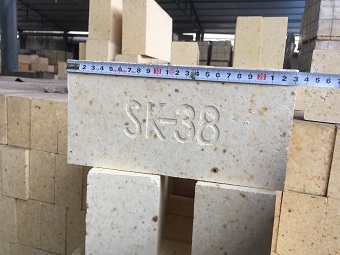Application of high alumina brick
2022-04-12
Ordinary high alumina brick refers to the commonly used standard fired brick, while modified high alumina brick mainly refers to four kinds: high load soft high alumina brick, micro expansion high alumina brick, low creep high alumina brick and phosphate bonded high alumina brick.
1. Ordinary high alumina brick.
The main mineral composition of high alumina brick is mullite, corundum, and glass phase. Ordinary high alumina bricks are mainly used for lining blast furnaces, hot blast furnaces, electric furnace tops, blast furnaces, reflection furnaces, and rotary kilns.
2. High load soft high alumina brick.
(1) In addition to adding three stone concentrate, high alumina materials (ground high alumina bauxite, industrial alumina or a-Al2O3 micro powder, corundum powder, and high alumina corundum powder) are reasonably introduced according to the theoretical composition of mullite after combustion.
(2) High quality spherical clay shall be selected as the binder, and clay composite binder or mullite binder shall be used according to different varieties. By adopting the above methods, the load softening temperature of high alumina brick is increased by 50-70 ℃.

3. Micro expansion high alumina brick
In order to make the high alumina brick expand properly in the use process, the key is to select the three stone minerals and their particle size, and control the firing temperature, so that some of the selected stone minerals are mullitized and some of the three stone minerals remain. The residual three stone minerals are further mullitized (primary or secondary Mullitization) during use, accompanied by expansion reaction. The three-stone minerals selected are better than composites. Because the decomposition temperatures of the three stone minerals are different. The expansion produced by Mullitization is also different. Using this feature, high alumina brick has a corresponding expansion effect due to different working temperatures. Squeeze the brick joint and improve the overall compactness of the brick, so as to improve the anti-slag permeability of the brick.
4. Low creep high alumina brick
The assessment index of clay brick and high alumina brick used in hot blast stoves for a long time in China is mainly the load softening temperature, and the index requirement of butterfly rate is not put forward. After years of use, there are problems such as brick deformation, cracking, and sinking. If the air temperature of the hot blast stove increases, such problems will become more prominent. With the development of large volume, high air temperature technology, and longevity of iron-making blast furnaces, higher requirements are put forward for refractory materials for hot blast furnaces, which are required to withstand the effects of long-term thermal stress and high air temperature without easy damage. Therefore, high alumina bricks for hot blast stoves are required to have a low creep rate. This plays an important role in the longevity of a hot blast stove. The physical and chemical indexes of low creep high alumina brick are as follows: in order to solve the creep resistance of high alumina brick, the method of adding beneficial minerals is adopted and the so-called unbalanced reaction is used. When the creep temperature is 1550 ℃ and 1500 ℃, the additives are quartz and three stone minerals; When the creep temperature is 1450 ℃, 1400 ℃ and 1350 ℃, the additives are three stone minerals, and corundum and a-Al2O3 are introduced accordingly. Among them, three stone minerals and activated alumina are mainly added in the form of the matrix, and the complete or near-complete Mullitization of the matrix is the key. Because the Mullitization of the matrix will increase the mullite content and reduce the glass phase content of the material, the excellent mechanical and thermal properties of mullite are conducive to the improvement or improvement of the high-temperature properties of the material. The research shows that high load soft and low creep high alumina bricks for blast furnace hot blast stove with creep temperature of 1400-1450 ℃ can be prepared by adding 15% - 35% sillimanite concentrate in the production of high alumina bricks. For low creep high alumina bricks with creep temperature of 1500 ~ - 1550 ℃, in addition to adding an appropriate amount of sillimanite, a certain amount of mullite should be added; Or use some fused corundum and silica raw materials.
5.Phosphate bonded high alumina brick
The phosphoric acid solution, or aluminum phosphate solution as the binder, is formed by a semi-dry machine and heat-treated at 400-600 ℃. It belongs to unburned brick. In order to avoid large shrinkage of products during high-temperature use, it is necessary to introduce heating expansive raw materials, such as kyanite, sillimanite, pyrophyllite, silica, etc. Compared with ceramic bonded sintered high alumina, it has better spalling resistance, but its load softening temperature is low and its corrosion resistance is poor. Therefore, a small amount of fused corundum mullite should be added to strengthen the matrix. Phosphate bonded high alumina brick is suitable for cement kiln, electric furnace top, and ladle.
Relevant information
-

Silicate fire brick
Silicon thermal insulation refractory brick refers to the thermal insulation refractory products made of silica as the main raw material, with a SiO2 content of no less than 91%. In addition to the heat insulation perfor··· -

silica bricks manufacturing process
1.1 Determination of raw material ratio and particle compositionThe raw materials for making silica bricks are silica and waste bricks containing more than 96% SiO2, in addition to lime, mineralizers and organic binders.··· -

Alumina hollow ball bricks
Alumina hollow ball bricks are made of alumina hollow balls and alumina powder as the main raw materials, combined with other binders, and fired at a high temperature of 1750 degrees. It belongs to a kind of ultra-high t··· -

Anti-stripping high alumina brick for cement kiln
Anti-stripping high alumina bricks are made of high alumina bauxite clinker, mullite, kyanite, zircon sand, and binder first through granulation and powdering processes, mixed in a certain proportion, then pressed into s···

